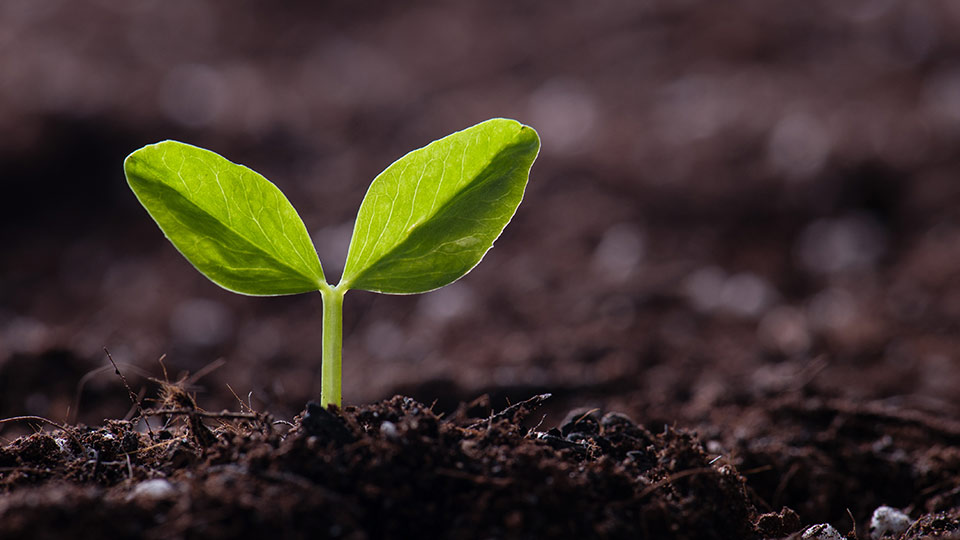
Actively Aerated Compost Teas (AACTs)
Rocky Mountain Organic Supply Tea Recipe Click Here!
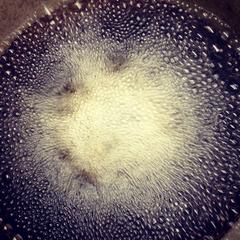 Actively Aerated Compost Teas are an integral part of any organic gardeners growing regiment. AACT is the process of taking very high quality compost, vermicompost or worm castings and growing the microbial populations in that material hundreds of thousands of times to millions of times through the process of brewing with clean aerated water and microbial foods. Once the brew is finished you have a liquid soil or foliar inoculant bursting with healthy microbiology that goes right to work in replenishing or helping correct a deficiency present in your current soil food web, or helping any foliar issues you may be having.
Actively Aerated Compost Teas are an integral part of any organic gardeners growing regiment. AACT is the process of taking very high quality compost, vermicompost or worm castings and growing the microbial populations in that material hundreds of thousands of times to millions of times through the process of brewing with clean aerated water and microbial foods. Once the brew is finished you have a liquid soil or foliar inoculant bursting with healthy microbiology that goes right to work in replenishing or helping correct a deficiency present in your current soil food web, or helping any foliar issues you may be having.
Download our basic starter recipes for tea brewing and what we recommend after years of working with teas and lots of PhD backed research.
As you become more comfortable with brewing teas you can expand upon these recommendations but ideally you would do so only after learning how to identify organisms under a microscope to ensure what you are brewing up is healthy and not filled with bad soil food web microbes. By sticking to our recommendations you will be very successful in this endeavor and your gardens and lawns will thank you many times over through less water usage and disease resistance. Using teas can help revitalize dirt and turn it into productive soil!
Items needed – Most of these items can be bought at your local Hydroponics shop or pet store, so the links below are to give you an idea of what you need to get. If you would rather buy off the internet you can find these items through Amazon or other retailers.
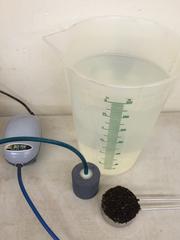 Brewing container – This can be as simple as a pitcher or even a 5 gallon bucket from the hardware store. This can also go as large as you need, scaling isn’t an issue, it just takes different equipment. Lots of people start small with a 5 gallon bucket and eventually graduate into many 5 gallon buckets or even trash cans or 55 gallon drums. You want to make sure to thoroughly clean this container after each brew as you don’t want to have bad guys take up home in a dirty container for the next tea brew.
Brewing container – This can be as simple as a pitcher or even a 5 gallon bucket from the hardware store. This can also go as large as you need, scaling isn’t an issue, it just takes different equipment. Lots of people start small with a 5 gallon bucket and eventually graduate into many 5 gallon buckets or even trash cans or 55 gallon drums. You want to make sure to thoroughly clean this container after each brew as you don’t want to have bad guys take up home in a dirty container for the next tea brew.
Air pump – This is what brings oxygen into the water and will make sure all of the good microbial populations have plenty of oxygen to grow with and survive on. You want to make sure you choose the appropriate pump for the application you will be doing. If you are looking to only do 1 pitcher of tea at a time you only need a very small air pump, if you will be doing larger batches you need to make sure you have a large enough air pump to handle the larger population of microbes you will be brewing up. If you do not have a large enough air pump as the microbiology grows it will consume all of the available oxygen faster than it is being produced and dissolved into the water which will turn the tea from aerobic (with oxygen) into anaerobic (without oxygen). Anaerobic teas are not good and will spread bad organisms into your soil and onto your plants. There are some anaerobic teas we do make for special conditions, but when an AACT becomes anaerobic it is never good.
Smaller air pumps:
Larger air pumps:
- EcoPlus 793 GPH (3000 LPH, 18W) Commercial Air Pump w/ 6 Valves | Aquarium, Fish Tank, Fountain, Pond, Hydroponics
- Active Aqua Commercial Air Pump, 6 Outlets, 20W, 45 L/min
Air stone or Dewey Mister
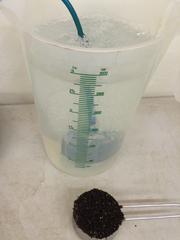 This is what diffuses the oxygen from the air pump into the water. Depending on the size of tea you are brewing will dictate the number of air stones you will need or Dewey Misters. These will also need to be cleaned after each brew to ensure bad microbes don’t take up home in your brewing equipment. For smaller brews (pitchers up to 5 gallon buckets) air stones can work great, bigger stones are needed for a 5 gallon bucket as opposed to smaller buckets and pitchers, or you can use multiple stones if the air pump you have has multiple outputs. For larger brews starting at 5 gallons and on up you will want to move to the Dewey Misters in most cases as they are easy to clean and do a wonderful job of aeration. You need a much larger air pump to run the Dewey Misters.
This is what diffuses the oxygen from the air pump into the water. Depending on the size of tea you are brewing will dictate the number of air stones you will need or Dewey Misters. These will also need to be cleaned after each brew to ensure bad microbes don’t take up home in your brewing equipment. For smaller brews (pitchers up to 5 gallon buckets) air stones can work great, bigger stones are needed for a 5 gallon bucket as opposed to smaller buckets and pitchers, or you can use multiple stones if the air pump you have has multiple outputs. For larger brews starting at 5 gallons and on up you will want to move to the Dewey Misters in most cases as they are easy to clean and do a wonderful job of aeration. You need a much larger air pump to run the Dewey Misters.
Air stones:
Dewey Misters:
- Shop for Dewey Misters – Currently Sold Out
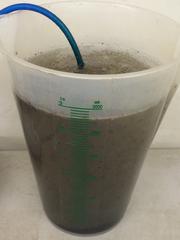 Air pump tubing – This is not usually included with the air pumps or the air stones and is required to tube from the air pump which sits outside of the brewing container to the air stone or Dewey Misters. You need 6mm/0.23” external diameter tubing (4mm/0.16” internal diameter).
Air pump tubing – This is not usually included with the air pumps or the air stones and is required to tube from the air pump which sits outside of the brewing container to the air stone or Dewey Misters. You need 6mm/0.23” external diameter tubing (4mm/0.16” internal diameter).
Air tubing:
- 6mm/4mm Translucent Silicone Flexible Airline Tubing for Aquariums Fish Tanks (25 Feet)
- Deep Blue Professional ADB12296 Silicone Air Tubing for Aquarium, (Assorted Colors)
- Elite Silicone Airline Tubing for Aquarium, 10-Feet, Blue
Clean water – One of the most important elements is having water that isn’t loaded with chlorine or chloramine (the new stronger chlorine they are adding to almost all city waters). Traditionally you only had to bubble water for 24 hours to make sure all of the chlorine is gone so it doesn’t kill off the microbiology you are trying to grow, now most cities are having to put chloramine in the water (call your local utilities company to inquire as to if they are adding this in). If you have chloramine in your water it will not leave through evaporation like chlorine, rather you must first bubble the water to get rid of the chlorine just like before but now you must also mix in an acid source such as lemon juice, lime juice or humic acid to remove the chloramine. You will add ¼ teaspoon of your chosen acid source per gallon of water and mix thoroughly to neutralize the chloramine.
***NEVER USE – Blackstrap molasses***
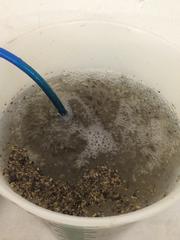 If you do some of your own reading online about compost tea brewing one of the biggest things you will run across is the recommendation to use blackstrap molasses as the microbial food in the tea. This used to be widely accepted as a great way of brewing tea. The issue is that without a firm understanding of soil biology and what microbes look like under a microscope people actually brew up anaerobic teas the majority of the time with blackstrap molasses. This is why that happens even with an air pump — molasses is a simple sugar which feeds bacterial populations very quickly basically as junk food. As the bacterial populations grow they take over the entire tea and use up all the oxygen, this causes the tea to become anaerobic as soon as the ppm (parts per million) of dissolved oxygen drop below 8 (6ppm is the critical point). There are plenty of bacteria all over this planet and we really don’t need to brew up heavy bacterial teas, rather we want to brew up complex teas that have a huge variety of life in them, not only bacteria but also fungi, protozoa and nematodes. When you only feed simple sugars to the microbiology in the tea brewing process the bacteria will out multiply all the other good guys and take over the entire tea. We instead feed complex foods to the tea so the fungi, protozoa and nematodes have a chance to grow and multiply. If you really want to use molasses in your brewing it is highly advisable to also get yourself a microscope so you can monitor the tea and make sure you use it before it goes anaerobic. As that is not practical for most home gardeners your best bet is to follow our simple recipes for wonderful results.
If you do some of your own reading online about compost tea brewing one of the biggest things you will run across is the recommendation to use blackstrap molasses as the microbial food in the tea. This used to be widely accepted as a great way of brewing tea. The issue is that without a firm understanding of soil biology and what microbes look like under a microscope people actually brew up anaerobic teas the majority of the time with blackstrap molasses. This is why that happens even with an air pump — molasses is a simple sugar which feeds bacterial populations very quickly basically as junk food. As the bacterial populations grow they take over the entire tea and use up all the oxygen, this causes the tea to become anaerobic as soon as the ppm (parts per million) of dissolved oxygen drop below 8 (6ppm is the critical point). There are plenty of bacteria all over this planet and we really don’t need to brew up heavy bacterial teas, rather we want to brew up complex teas that have a huge variety of life in them, not only bacteria but also fungi, protozoa and nematodes. When you only feed simple sugars to the microbiology in the tea brewing process the bacteria will out multiply all the other good guys and take over the entire tea. We instead feed complex foods to the tea so the fungi, protozoa and nematodes have a chance to grow and multiply. If you really want to use molasses in your brewing it is highly advisable to also get yourself a microscope so you can monitor the tea and make sure you use it before it goes anaerobic. As that is not practical for most home gardeners your best bet is to follow our simple recipes for wonderful results.
Tea Ingredients: Recommendations on where to source ingredients if you cannot find them locally in any of the garden/hydroponic shops around your area.
- Worm Castings
- Kelp Meal
- Alfalfa Meal
- Fish Hydrolysate
- Soft Rock Phosphate
- Bat Guano
- Fish Bone Meal
- Humic Acid
How to brew your tea:
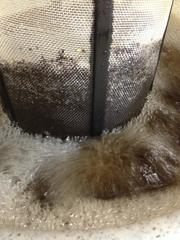 Once you have everything sourced and the water is chlorine and chloramine free it is as simple as putting the air stone or Dewey Mister into the water and adding in the appropriate amount of ingredients each tea calls for. You can put them into a ‘tea bag’ like a nylon stocking or even a sock but it really is best to let everything free float in the water to get better surface coverage for the microbiology. Brew for the recommended amount of time and then water your plants either in the morning or evening, since the UV rays from the sun kill the microbiology – so you want to make sure the tea isn’t brewing in the sun or that you apply it during the heat of the day. During the summer you can brew outside in the shade perfectly fine. Once the temperatures start to fall you will want to move any brewing you do inside where there are more stable overnight temperatures.
Once you have everything sourced and the water is chlorine and chloramine free it is as simple as putting the air stone or Dewey Mister into the water and adding in the appropriate amount of ingredients each tea calls for. You can put them into a ‘tea bag’ like a nylon stocking or even a sock but it really is best to let everything free float in the water to get better surface coverage for the microbiology. Brew for the recommended amount of time and then water your plants either in the morning or evening, since the UV rays from the sun kill the microbiology – so you want to make sure the tea isn’t brewing in the sun or that you apply it during the heat of the day. During the summer you can brew outside in the shade perfectly fine. Once the temperatures start to fall you will want to move any brewing you do inside where there are more stable overnight temperatures.
How to use your tea:
You can dilute the tea down 1:1 (tea to clean water), but it works perfectly fine as a direct application. Teas can be applied several times a week for heavy feeding plants, but once a week is perfectly fine and even just a couple times a month during the growing season is helpful. If you plan on foliar spraying with teas make sure you strain it out so you won’t clog your sprayer. Never put teas into a metal watering can as the zinc inside the metal will kill the microbes! Make sure you use teas within 24 hours of brewing, ideally within 4 hours of the brew cycle finishing to ensure the highest microbial populations. If you make too much tea simply apply it to your compost pile. You can also use the left over tea sludge around the base of plants, or it works great in a compost pile.
Compost tea brewing is a rather simple process and we highly recommend it to anybody who is an organic gardener/landscaper. Contact us with any questions; we would be happy to help!